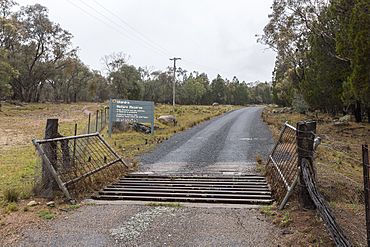Ulandra Nature Reserve facts for kids
Quick facts for kids Ulandra Nature ReserveNew South Wales |
|
|---|---|
|
IUCN Category Ia (Strict Nature Reserve)
|
|

Tower Road entrance into Ulandra Nature Reserve
|
|
| Nearest town or city | Cootamundra |
| Established | June 1981 |
| Area | 39.3 km2 (15.2 sq mi) |
| Managing authorities | NSW National Parks and Wildlife Service |
| Website | Ulandra Nature Reserve |
| See also | Protected areas of New South Wales |
The Ulandra Nature Reserve is a special protected area in New South Wales, Australia. It's located in the western hills of the Southern Tablelands and eastern Riverina regions. This reserve covers about 3,930-hectare (9,700-acre) of land.
You can find it about 25 kilometres (16 mi) south-west of Cootamundra. It's also about 4 kilometres (2.5 mi) south-east of the small village of Bethungra.
The main feature of the reserve is Mount Ulandra. The land west of the reserve is mostly flat, around 200 to 300 metres (660 to 980 ft) above sea level. But then, Mount Ulandra rises sharply to its peak at 761 metres (2,497 ft) high.
The reserve was created in 1981. Its main goal was to protect areas of Cootamundra wattle trees. It also provides a safe home for the threatened superb parrot to find food and raise its young. More land was added to the reserve until 1983.
Ulandra Nature Reserve is listed on the Register of the National Estate. This means it's a very important place. It has rare open forests with cypress pine and eucalyptus trees. These types of plants are not found much elsewhere in the region.
The reserve is also a key place for the threatened superb parrot. Another vulnerable bird, the turquoise parrot, also lives here. Many other animals that are rare in the area find a home in Ulandra. It also has a very natural creek, which is unusual in farming areas.
Contents
What's Inside Ulandra Reserve?
The Ulandra Nature Reserve covers a range of hills called the Ulandra Range. The land is quite hilly with rough, rocky ridges. There are also several steep, narrow valleys. A creek called Merrybundinah Creek flows through the reserve. Most of the reserve is over 500 metres (1,600 ft) above sea level.
Plants and Trees
The reserve is mostly covered in open forests. You'll find cypress pine trees and different kinds of gum trees. Many types of wattle trees also grow here.
Amazing Animals
The reserve is home to many animals. You might spot grey kangaroos and swamp wallabies. There are also brushtail possums and ringtail possums. Many types of bats live here too, though their exact numbers are not known.
As of July 2015, over 100 different bird species have been seen in the reserve. Some of these birds are considered 'vulnerable' in New South Wales. This means they need special protection.
These vulnerable birds include:
- The little eagle
- The gang-gang cockatoo
- The turquoise parrot
- The brown treecreeper
- The speckled warbler
- The varied sittella
- The hooded robin
- The scarlet robin
- The flame robin
- The diamond firetail
A Look Back in Time
The reserve holds clues about Aboriginal history. Stone tools and other old items have been found here. This shows that Aboriginal people lived and used this land long ago.
After Europeans arrived, people used the reserve for different activities. They cleared some land and let farm animals graze there. Some timber was also cut down. You can still see signs of these past activities. There are old fence lines, stockyards, buildings, and dams.
Keeping the Reserve Safe
The reserve faces some challenges. There is damage from past clearing and building dams for farm animals. Introduced animals like pigs also cause problems. They compete with native animals and can harm the environment.
Weeds that are not native to the area are also a problem. They can spread and take over from the natural plants.
There is a small area within the reserve that has communication towers. These towers can be seen from many parts of the reserve.
It's important to remember that Ulandra is a nature reserve. This means you need special permission to enter it. You must get this permission from the NSW National Parks and Wildlife Service. This rule helps protect the reserve's plants and animals.


